Your child has come home from the hospital with an indwelling urinary catheter. A urinary catheter is a thin tube that drains urine (pee) from your child's bladder to the outside of the body. An indwelling urinary catheter has a balloon that holds the tube in place within the bladder wall.
There are some things you need to do to look after your child's catheter at home. Parents and older children can learn how to care for a catheter. Before your child goes home, a nurse will show you and your child what to do. This page also explains what to do.
There are different types of indwelling urinary catheters:
- A Foley catheter enters your child's bladder through the tube that carries urine out of the body (the urethra).
- A suprapubic catheter enters your child's bladder through a cut in the belly.
How to care for the catheter
- Make sure your child is well hydrated and drinking the amount of fluids recommended by their health-care team.
- Wash your hands with soap and water before and after you touch the catheter or urine.
- Check the catheter tubing every hour for leaks, loops or kinks.
- Keep your child's catheter secured firmly in place with tape or a catheter adherence device provided by their health-care team. Your child's nurse will show you how to do this before you leave the hospital.
- Never try to take the catheter out or put it back in by yourself, if you have not been directed to do so.
- Always keep the catheter drainage bag lower than your child's bladder.
- For children who have not yet learned how to use the toilet, use the double diaper method: two diapers worn at once. The inner diaper is for stool and the outer diaper is for urine. The end of the catheter should be placed in the outer diaper.
- For children who have learned to use the toilet, the end of the catheter should be connected to a leg bag (during the daytime) or regular large drainage bag (overnight). Empty the drainage bag when it is half- to two-thirds full.
- Clean your child's skin around the catheter every day with soap and water or cleansing wipes.
- Avoid activities that may result in accidental removal of the catheter.
- Make sure the balloon is filled properly.
- Make sure there is an adherence device or tape to hold the catheter in place. The type of device will differ based on your child’s age.
- Give your child all of their medicine exactly as prescribed by their health-care provider.
- Irrigate (flush) your child's catheter as directed by their health-care provider.
Your child's catheter needs to be irrigated
From time to time, your child's catheter needs to be irrigated (flushed with water). This helps the urine to drain freely.
Parents and older children can learn how to irrigate the catheter at home.
Your child's catheter will need to be irrigated on a schedule, as indicated by their health-care team, and as needed if urine stops draining, there is minimal drainage, or lots of debris/mucus is noted in the urine.
You will need supplies
You will need the following supplies each time you irrigate your child's catheter:
- alcohol swabs
- a sterile salt-water mixture called normal saline solution (medical grade)
- a 60 mL syringe with a tapered end called a slip tip syringe
- a sterile specimen container
- a paper towel or other clean towel
To irrigate the catheter, follow these steps:
-
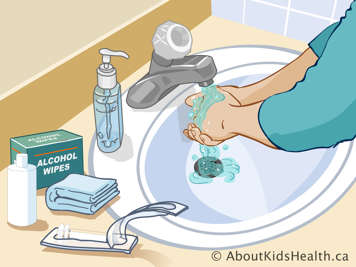
Gather the supplies you will need. Wash your hands with soap and water.
- Measure out 60 mL of sterile normal saline solution (medical grade) and pour it into a sterile specimen container.
- Take off the cap of a slip tip syringe and withdraw 60 mL of the normal saline from the container. Note: This volume may differ based on the size of your child, so ask your child’s health-care team how much normal saline to use. Place the syringe cap back onto the syringe to keep the tip sterile. Do not let the tip of the syringe touch anything else.
-
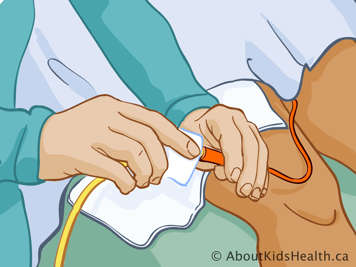
Make sure your child’s bladder is completely emptied and place a clean towel or paper towel under the catheter where it connects to the drainage bag. Use an alcohol swab to clean the connection site.
-
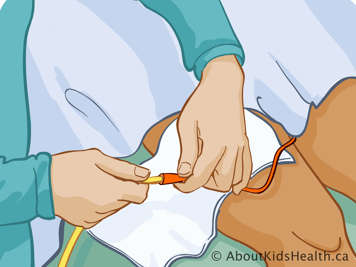
The catheter tube is shown in orange, and the end of the drainage bag tubing is shown in yellow. Pinch the catheter between your thumb and forefinger and disconnect the drainage bag from the end of the catheter. Discard the drainage bag or secure the end with a cap if you are planning to continue using it after irrigation. Hold the pinched end of the catheter and use an alcohol swab to clean the tip of the catheter.
-
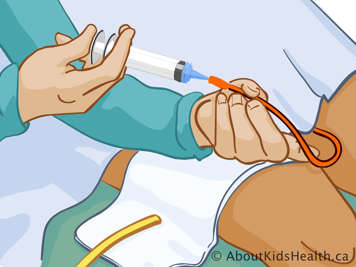
Attach the sterile syringe to the end of the catheter and stop pinching the catheter. Gently push the plunger so all the normal saline solution flows through the catheter. Once the normal saline is all in, gently pull back on the plunger to take it back out and discard this solution. Your child’s health-care team may ask you to repeat this step several times until the solution that is drawn back is completely clear with no debris.
-
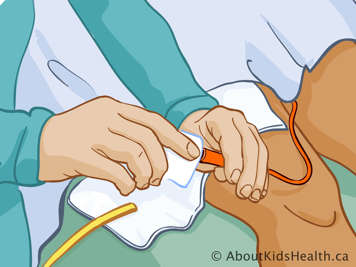
Pinch the catheter and remove and discard the syringe. Clean the tip of the catheter with an alcohol swab, and clean the tip of the drainage bag tubing with an alcohol swab once more.
- Reconnect the catheter to the drainage bag tubing. Wash your hands again.
If it is hard to pull back on the plunger
Do not use force to pull back hard on the plunger. This could hurt your child's bladder. Instead, gently try to pull back again.
If it is still hard to pull back
Readjust the position of the catheter. Withdraw another 60 mL of normal saline using a catheter tip syringe irrigate the catheter again. Gently pull back on the plunger to take the normal saline back out.
Connect your child's catheter to the drainage tubing again. Watch for a good flow of urine.
- If urine flows well, irrigate again at the next scheduled time.
- If urine does not flow, bring your child to the hospital's Emergency Department right away. If your child's health-care team tells you to do something else, do what they tell you.
If your child’s health-care team recommends aggressive irrigation, further instructions will be given.
Tips for irrigation
- Giving the normal saline at cooler temperatures or too quickly can cause painful bladder spasms. These can be avoided by bringing the normal saline to room temperature and by pushing the plunger slowly when administering the solution. You can bring the solution to room temperature by either leaving the solution out in a sealed container to gradually reach room temperature or warming it within the sterile container under warm tap water.
- For instructions on clean intermittent catheterization (CIC), see CIC: Instructions for children with male anatomy and CIC: Instructions for children with female anatomy.
When to seek medical attention
Go to the nearest Emergency Department if:
- your child has a fever greater than 38°C (100.4°F)
- the catheter is accidentally removed and you have not been taught how to insert it or you have been instructed not to reinsert it
- the catheter continues to stay blocked after irrigating it
- there is blood in your child’s urine, especially if you see bright red or clots.
At SickKids
For urgent concerns after hours or on weekends, please consult your child’s primary care provider, visit your local Emergency Room or the SickKids Emergency Unit.
If your child needs to prepare for surgery, see Coming for surgery.
A child life specialist can also help to prepare and support your child if they are anxious about an operation.
Useful websites
SickKids Division of Pediatric Urology – www.sickkids.ca/en/care-services/clinical-departments/urology/
Canadian Urological Association (CUA) – www.cua.org
Resources for purchasing supplies
CathetersPLUS (Red Leaf Medical)
Email: info@cathetersplus.com
Toll Free: 1-877-563-7422
Wellwise by Shoppers Drug Mart
Coloplasty
Email: casupport@coloplast.com
Customer service: 1-888-880-8605
5Fifty5 Shop at SickKids
(416) 813-8555
